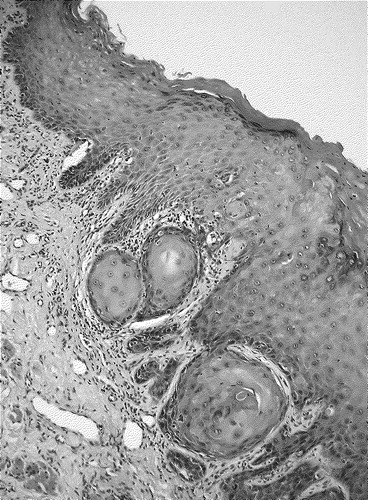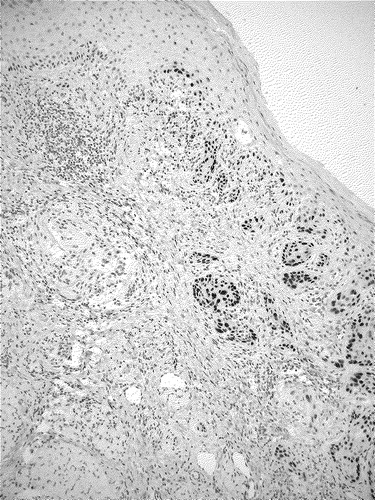To the Editor:Ocular surface squamous neoplasia (OSSN) includes conjunctival intraepithelial neoplasia with dysplasia, conjunctival carcinoma in situ and conjunctival squamous cell carcinoma (SCC). The incidence of OSSN is approximately 2 per 100 000 per year Citation[1]. Documented cases of bilateral neoplasia/dysplasia are rare Citation[2]. OSSN has been associated with ultraviolet B irradiation, human papillomavirus type 16 and 18, p53 gene overexpression, herpes-simplex-virus type 1, trauma, flour, arsenic, tobacco, vitamin A deficiency, immunodeficiency, atopic keratoconjunctivitis and xeroderma pigmentosum Citation[3–5]. In sinonasal carcinomas wood dust and wood additives are discussed as carcinogenic factors Citation[6–10]. We report on a patient with bilateral OSSN associated with a 30 year exposure to wood dust.
A 75-year-old man was referred with a one year history of a small tumour of the tarsal conjunctiva of the right lower eyelid and a large neoplasm of the tarsal conjunctiva of the left upper eyelid. Visual acuity was 20/25 on both eyes. He had a history of chronic obstructive pulmonary disease and radical prostatectomy due to prostate carcinoma with no evidence of recrudescence or metastatic disease in recent urologic controls. The patient reported a 30-year exposure to wood dust for professional reasons. A bilateral full thickness biopsy of both bilateral tumours was performed. Histopathology of the tumour of the right eye revealed a completely removed conjunctival squamous cell carcinoma with only slight invasion. Histopathology of the neoplasm of the left eye disclosed an invasive moderate differentiated conjunctival squamous cell carcinoma (). On immunohistochemistry, the tumour of the conjunctiva presented with p53-protein overexpression, seen only in the nuclei of the carcinoma, which contrasts to the p53-negative epithelium in the vicinity (). The polymerase chain reaction based assay proved negative for HPV-DNA in both of the bilateral tumours. Eight months after complete removal of the tumour the patient presented with an extensive relapse on the left eye, covering parts of the tarsal conjunctiva of the upper eyelid and the entire tarsal conjunctiva of the lower eyelid. He underwent full thickness excision with partly removal of the lower eyelid. Histopathologically, a recurrent moderately differentiated squamous cell carcinoma of the conjunctiva was found, which could be excised completely. After one year follow up no recrudescence occurred.
Figure 1. Invasive moderate differentiated squamous cell carcinoma of the conjunctiva. Hematoxylin and eosin.

Figure 2. Invasive moderate differentiated squamous cell carcinoma of the conjunctiva. Immunohistochemically a clear strong overexpression of p53 is seen only in the nuclei of the carcinoma (lower right), which contrasts to the p53-negative epithelium in the vicinity (upper left). Anti-p53, avidin biotin complex method.

Documented cases of bilateral ocular surface squamous neoplasia (OSSN) are rare Citation[2]. OSSN in general and bilateral cases in particular have mainly been associated with ultraviolet B irradiation, human papillomavirus infection and p53 gene overexpression Citation[3–5], with the p53 overexpression generally being more indicative of an altered cell cycle control than being an etiopathogenetic cause. We report on a patient with bilateral OSSN with a history of a 30 year exposure to wood dust showing p53 gene overexpression. A large excess risk for sinonasal carcinomas has been documented among workers in wood-related occupations, particularly adenocarcinomas, and workers exposed to wood additives, particularly squamous cell carcinomas Citation[6–10]. However, the pathophysiologic mechanisms of the carcinogenesis are unknown. In our patient the lack of well-established associations to a rare bilateral tumour let us think about other possible associations. Comparable to sinonasal carcinomas we suggest for the first a possible role of wood dust and/or wood additives in the carcinogenesis of OSSN.
Declarations
The authors indicate that the case has not been presented previously. The authors indicate no potential conflicts of interest.
References
- Lee GA, Hirst LW. Incidence of ocular surface epithelial dysplasia in metropolitan Brisbane. A 10-year survey. Arch Ophthalmol 1992; 110: 525–7
- Odrich MG, Jakobiec FA, Lancaster WD, Kenyon KR, Kelly LD, Kornmehl EW, et al. A spectrum of bilateral squamous conjunctival tumors associated with human papillomavirus type 16. Ophthalmology 1991; 98: 628–35
- Guthoff R, Lieb WE, Strobel P, Zehl A, et al. Exenteration of invasive conjunctival squamous cell carcinoma. Br J Ophthalmol 2004; 88: 1093–4
- Cervantes G, Rodriguez AA, Jr, Leal AG. Squamous cell carcinoma of the conjunctiva: clinicopathological features in 287 cases. Can J Ophthalmol 2002; 37: 14–19;19–20
- Basti S, Macsai MS. Ocular surface squamous neoplasia: A review. Cornea 2003; 22: 687–704
- Luce D, Leclerc A, Begin D, Demers PA, Gerin M, Orlowski E, et al. Sinonasal cancer and occupational exposures: a pooled analysis of 12 case-control studies. Cancer Causes Control 2002; 13: 147–157
- Armstrong RW, Imrey PB, Lye MS, Armstrong MY, Yu RC, Sani S, et al. Nasopharyngeal carcinoma in Malaysian Chinese: occupational exposures to particles, formaldehyde and heat. Int J Epidemiol 2000; 29: 991–8
- t’ Mannetje A, Kogevinas M, Luce D, Demers PA, Begin D, Bolm-Audorff U, et al. Sinonasal cancer, occupation, and tobacco smoking in European women and men. Am J Ind Med 1999; 36: 101–7
- Pollan M, Lopez-Abente G. Wood-related occupations and laryngeal cancer. Cancer Detect Prev 1995; 19: 250–7
- Hadfield EH. Damage to the human nasal mucosa by wood dust. Inhaled Part 1970; 2: 855–61
